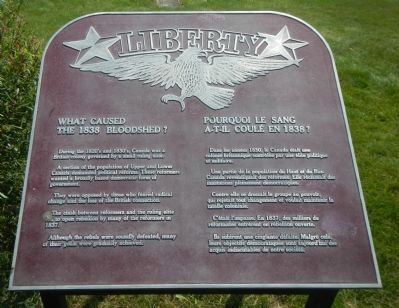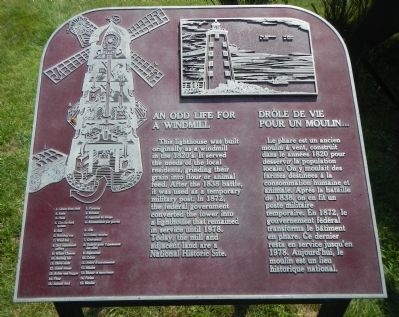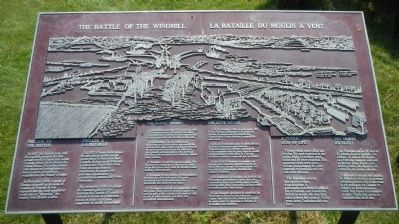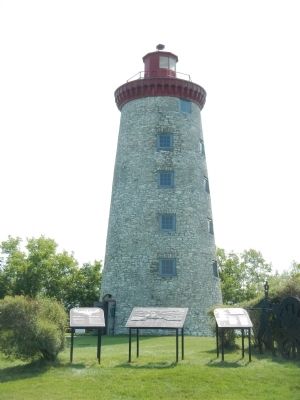Near Prescott in Leeds and Grenville United Counties, Ontario — Central Canada (North America)
The Battle of the Windmill
La Bataille du Moulin à Vent
Inscription.
English:
Prelude to the Battle
In 1837 the British army and loyal militia crushed the first armed revolt in Upper and Lowr Canada. Many rebels fled to the United States. The exiles joined with American sympathisers to form a secret paramilitary organization, the Hunter’s Lodge.
In November 1838, a group of Hunters planned an invasion of Canada at Prescott. It was expected that the local population would join in “liberating” the country from British control.
The Battle Unfolds
1. Early on the morning of November 12, 1838, 190 Hunters landed at Windmill Point. Most were Americans. Contrary to their expectations, the local population did not rally to their side.
2. By November 13, over 2,000 local militiamen and British soldiers surrounded the rebel positon. After a bitter and bloody skirmish, the government forces drove the rebels into the windmill and surrounding stone buildings. But they could not attack these buildings without large cannons.
3. November 14 and 15 were uneventful. The Hunters were counting on help from the United States that never came, while the British awaited artillery reinforcements.
4. November 16 was decisive, British gunboats patrolled the river while their field guns arrived by land. In the afternoon, they bombarded the rebels for two hours.
5. The Hunters were low on ammunition, food and water. They were no medical supplies to ease the pain of the wounded. By nightfall, they ran out of both resources and hope, and surrendered unconditionally.
A Futile Loss of Life?
Twenty rebels were killed and another 20 were wounded in the battle, while 15 soldiers were killed and 55 were wounded. The captured rebels were tried. Eleven were hanged, 60 were deported to Australia and the rest were released.
The Rebellion was an expression of deep dissatisfaction. It profoundly transformed political life in Canada, and forced the British to review the way they administered the country. Thirty years later, Confederation was born.
French:
Prelude à la Bataille
En 1837, l’armée britannique étouffe une première révolte armée dans le Haut et la Bas-Canada. Beaucoup de Patriotes s’exilent aux Étas-Unis. Avec l’aide de sympathisants américains, ils mettent sur pied une organisation paramilitaire secrète, les Frères Chasseurs.
En novembre 1838, un groupe de Chasseurs planifie une invasion du Canada à Prescott. Il s’attend à ce que la population locale se joigne à lui pour supprimer la tutelle britannique.
Une Luette Inégale
1. Le 12 novembre 1838, au petit matin, 190 Frères Chasseurs débarquent à la pointe du Moulin. La plupart sont des Américains. Contrairement à leurs attentes, la population reste loyale.
2. Dès le 13 novembre, plus de 2 000 miliciens et soldats britanniques encerclent les Chasseurs. Après une violente escarmouche, ils les repoussent dans les murs épais du moulin et des bâtiments voisins. Mais ils n’ont pas d’artillerie lourde et ne peuvent pas les déloger.
3. Les 14 et 15 novembre se passent sans combat. Les Chasseurs espèrent recevoir des États-Unis une aide qui n’arrivers jamais. De leur côté, les Britanniques attendent des renforts d’artillerie.
4. La journée de 16 novembre est décisive. Les Britanniques patrouillent le fleuve dans des canonnières. Sur la terre ferme, leurs canons arrivent enfin. Dans l’après-midi, ils bombardent le moulin pendant deux heures.
5. Les Chasseurs manquent de munitions, de nourriture et d’eau. Ils n’ont rein pour soigner leurs blessés. à la tombée de la nuit, ils sont à court de ressources et d’espoir. Ils se rendent sans condition.
Des Morts Inutiles?
Les Patriotes ont eu 20 tués et 20 blessés dans la bataille. Les soldats, 15 tués et 55 blessés. Les Patriotes capturés subirent un procès. Onze d’entre eux furent pendus, 60 déportés en Australie, les autres relâchés.
Ces morts n’ont pas été inutiles, La Rébellion révélait un profound mécontentement.

Photographed By Barry Swackhamer, August 8, 2014
3. What caused the 1838 bloodshed” / Pourquoi le sang a-t-il coulé en 1838?
English:
During the 1820’s and 1830’s, Canada was a British colony governed by a small ruling elite.
A section of the population of Upper and Lower Canada demanded political reforms. These reformers wanted a broadly based democratic form of government.
They were opposed by those who feared radical change and the loss of the British connection.
The clash between reformers and the ruling elite led to open rebellion by many of the reformers in 1837.
Although the rebels were soundly defeated, many of their goals were gradually achieved.
French:
Dans les années 1830, le Canada était une colonie britannique contrôlée par un elite politique et militaire.
Une partie de la population du Haut et du Bas-Canada revendiquait des reformes. Elle réclamait des institutions pleinement démocratiques.
Contre elle se dressait le groupe au pouvoir, qui rejetait tout changement et voulait maintenir la tutelle coloniale.
C’était l’impasse. En 1837, des milliers de réformistes entrèrent en rébellion ouverte.
Ils subirent une cinglante défaite. Malgré cela, leur objectifs démocratiques sont aujourd’hui des acquis indiscutables de notre société.
During the 1820’s and 1830’s, Canada was a British colony governed by a small ruling elite.
A section of the population of Upper and Lower Canada demanded political reforms. These reformers wanted a broadly based democratic form of government.
They were opposed by those who feared radical change and the loss of the British connection.
The clash between reformers and the ruling elite led to open rebellion by many of the reformers in 1837.
Although the rebels were soundly defeated, many of their goals were gradually achieved.
French:
Dans les années 1830, le Canada était une colonie britannique contrôlée par un elite politique et militaire.
Une partie de la population du Haut et du Bas-Canada revendiquait des reformes. Elle réclamait des institutions pleinement démocratiques.
Contre elle se dressait le groupe au pouvoir, qui rejetait tout changement et voulait maintenir la tutelle coloniale.
C’était l’impasse. En 1837, des milliers de réformistes entrèrent en rébellion ouverte.
Ils subirent une cinglante défaite. Malgré cela, leur objectifs démocratiques sont aujourd’hui des acquis indiscutables de notre société.
Topics. This historical marker is listed in this topic list: Notable Events. A significant historical month for this entry is November 1838.
Location. 44° 43.27′ N, 75° 29.246′ W. Marker is near Prescott, Ontario, in Leeds and Grenville United Counties. Marker is on Windmill Road close to Leeds and Grenville Road (County Route 2), on the right when traveling east. Touch for map. Marker is at or near this postal address: 3401 Windmill Road, Prescott ON K0E, Canada. Touch for directions.
Other nearby markers. At least 8 other markers are within 3 kilometers of this marker, measured as the crow flies. A different marker also named The Battle of the Windmill (here, next to this marker); Welcome to the Site of The Battle of the Windmill (a few steps from this marker); Bytown and Prescott Railway Company 1850 (approx. 1.9 kilometers away); Col. Edward Jessup (approx. 2 kilometers away); Fort Wellington (approx. 2 kilometers away); Prescott War Memorial (approx. 2 kilometers away); World War II Memorial (approx. 2.2 kilometers away in the U.S.); Revolutionary War Memorial (approx. 2.2 kilometers away in the U.S.). Touch for a list and map of all markers in Prescott.
Also see . . . Battle of the Windmill - Wikipedia. In the aftermath of the battle,

Photographed By Barry Swackhamer, August 8, 2014
4. An Odd Life for a Windmill / Drôle de vie pour un Moulin
English:
This lighthouse was built originally as a windmill in the 1820’s. It served the needs of the local residents, grinding their grain into flour or animal feed. After the 1838 battle, it was used as a temporary military post. In 1872, the federal government converted it into a lighthouse that remained in service until 1978. Today, the mill and adjacent land are a National Historic Site.
French:
Le phare est un ancien moulin à vent, construit dans les années 1820 pour desservir la population locale. On y moulait de farines destinées à la consommation humaine de animale. Après la bataille de 1838, on et fit un poste militaire temporaire. En 1872, le gouvernement fédéral transforma le bâtiment en phare. Ce dernier resta en service jusqu’en 1978. Aujourd’hui, le moulin est un lieu historique national.
Click on this image to view the legend and details of the windmill.
This lighthouse was built originally as a windmill in the 1820’s. It served the needs of the local residents, grinding their grain into flour or animal feed. After the 1838 battle, it was used as a temporary military post. In 1872, the federal government converted it into a lighthouse that remained in service until 1978. Today, the mill and adjacent land are a National Historic Site.
French:
Le phare est un ancien moulin à vent, construit dans les années 1820 pour desservir la population locale. On y moulait de farines destinées à la consommation humaine de animale. Après la bataille de 1838, on et fit un poste militaire temporaire. En 1872, le gouvernement fédéral transforma le bâtiment en phare. Ce dernier resta en service jusqu’en 1978. Aujourd’hui, le moulin est un lieu historique national.
Click on this image to view the legend and details of the windmill.
Credits. This page was last revised on September 27, 2019. It was originally submitted on May 20, 2015, by Barry Swackhamer of Brentwood, California. This page has been viewed 375 times since then and 11 times this year. Photos: 1, 2, 3, 4. submitted on May 20, 2015, by Barry Swackhamer of Brentwood, California. • Andrew Ruppenstein was the editor who published this page.

